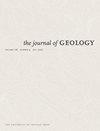北阿拉伯-努比亚盾(埃及南西奈)碰撞后的Ferani火山:岩石成因及其对埃迪卡拉纪(607-593 Ma)地球动力学演化的启示
IF 1.3
4区 地球科学
Q2 GEOLOGY
引用次数: 7
摘要
埃迪卡拉纪(607–593 Ma)Ferani火山岩暴露在西奈半岛南部,阿拉伯-努比亚地盾(ANS)的最北端。所研究的火山岩构成了一个同源的连续中间(安山岩到英安岩)到酸性(流纹岩到流纹岩)熔岩序列,具有高K钙碱性金属铝质到轻微过铝质性质。它们含有高浓度的大离子亲石元素(即Ba、Rb、Pb和Th),但Nb、P、Ti和Sr含量较低。与重稀土元素((Gd/Yb)N=1.10–2.29)相比,它们还普遍富集轻稀土元素(La/Sm)N=2.66–4.92),具有轻微的负Eu异常(Eu/Eu*=0.35-0.94)。根据热气压模型,Ferani岩浆的冷却始于约1000°-1100°C,并在低压(<5.1 kbar)和浅地壳水平(<17 km)下达到约700°C。镁铁质下地壳岩石的部分熔融程度较低,可能产生了穿过地壳上升并分馏的安山岩-英安质岩浆,导致了早期中期Ferani熔岩的产生。因此,中间熔体的渐进分级结晶可能形成了流纹岩和流纹岩熔体,这些熔体后来喷发形成了上层酸性Ferani火山序列。岩石学和地球化学特征支持了Ferani火山岩的碰撞后环境。岩石圈分层是ANS北部地壳碰撞后伸展阶段Ferani火山岩形成的主要地球动力学过程。本文章由计算机程序翻译,如有差异,请以英文原文为准。
Postcollisional Ferani Volcanics from North Arabian–Nubian Shield (South Sinai, Egypt): Petrogenesis and Implication for Ediacaran (607–593 Ma) Geodynamic Evolution
The Ediacaran (607–593 Ma) Ferani volcanic rocks are exposed in South Sinai, at the extreme northern tip of the Arabian-Nubian Shield (ANS). The studied volcanics constitute a cogenetic continuous intermediate (andesite to dacite) to acid (rhyodacite to rhyolite) lava sequence with a high-K calc-alkaline metaluminous to slightly peraluminous nature. They contain a high concentration of large-ion lithophile elements (i.e., Ba, Rb, Pb, and Th), but lower contents of Nb, P, Ti, and Sr. They also have a general enrichment in light rare earth elements ((La/Sm)N=2.66–4.92), compared to heavy rare earth elements ((Gd/Yb)N=1.10–2.29), with a slightly negative Eu anomaly (Eu/Eu*=0.35–0.94). The cooling of the Ferani magma began at ∼1000°–1100°C and went to ∼700°C at low pressure (<5.1 kbar) and shallow crustal levels (<17 km), according to thermobarometric modeling. The low degree of partial melting of the mafic lower-crustal rocks could have produced the andesitic-dacitic magmas that ascended through the crust and fractionated, leading to the production of the early intermediate Ferani lavas. Progressive fractional crystallization of the intermediate melts could consequently have formed the rhyodacite and rhyolite melts, which were later erupted to form the upper acidic Ferani volcanic sequence. Petrological and geochemical features support a postcollisional setting of the Ferani volcanics. Lithospheric delamination is the main geodynamic process responsible for the formation of the Ferani volcanics during the postcollisional extensional stage in the northern ANS crust.
求助全文
通过发布文献求助,成功后即可免费获取论文全文。
去求助
来源期刊

Journal of Geology
地学-地质学
CiteScore
3.50
自引率
5.60%
发文量
0
审稿时长
3 months
期刊介绍:
One of the oldest journals in geology, The Journal of Geology has since 1893 promoted the systematic philosophical and fundamental study of geology.
The Journal publishes original research across a broad range of subfields in geology, including geophysics, geochemistry, sedimentology, geomorphology, petrology, plate tectonics, volcanology, structural geology, mineralogy, and planetary sciences. Many of its articles have wide appeal for geologists, present research of topical relevance, and offer new geological insights through the application of innovative approaches and methods.
 求助内容:
求助内容: 应助结果提醒方式:
应助结果提醒方式:


